List of works by Leonardo da Vinci

This is a list of paintings attributed to Leonardo da Vinci, (baptised Leonardo di ser Piero da Vinci) (ⓘ), (April 15, 1452 – May 2, 1519), one of the leading artists of the High Renaissance. Fifteen works are generally attributed either in whole or in large part to him, most of them paintings on panel but including a mural, a large drawing on paper and two works in the early stages of preparation. A further six paintings are disputed, there are four recently attributed works, and two are copies of lost work. None of Leonardo's paintings are signed, and this list draws on the opinions of various scholars.[1]
The small number of surviving paintings is due to Leonardo's constant and frequently disastrous experimentation with new techniques, and his chronic procrastination. Nevertheless, these few works together with his notebooks, which contain drawings, scientific diagrams, and his thoughts on the nature of painting, comprise a contribution to later generations of artists rivaled only by that of his contemporary, Michelangelo.
Major extant works
| Image (sort by size) |
Details (sort by date) |
Attribution status | Location (sort by country) |
|---|---|---|---|
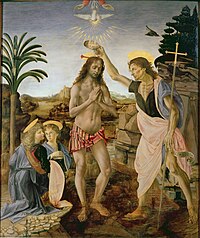
|
|
|
|

|
|
|
|
| Ginevra de' Benci |
|
||

|
|
|
|

|
|
|
|

|
|
|
|
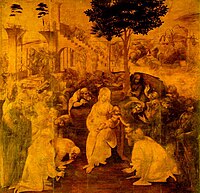
|
|
|
|

|
|
|
|

|
|
|
|

|
|
|
|

|
|
|
|

|
|
|
|
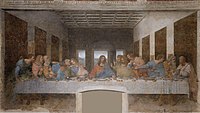
|
|
|
|
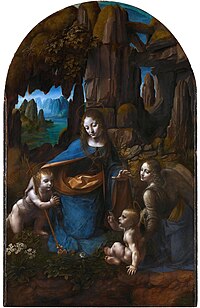
|
|
|
|

|
|
||

|
|
|
|

|
|
|
|

|
|
|
|
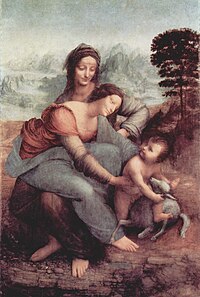
|
|
|
|

|
|
|
|

|
|
|
Lost works
| Image | Details | Notes |
|---|---|---|
| ||
|
| |
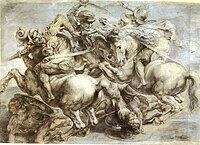
|
| |
|
| |

|
|
|
Disputed or recent attributions
| Image | Details | Attribution status | Location |
|---|---|---|---|

|
|
|
|
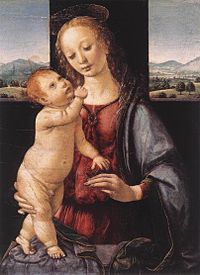
|
|
|
|
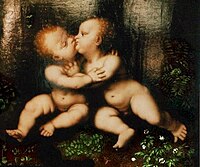
|
|
|
|
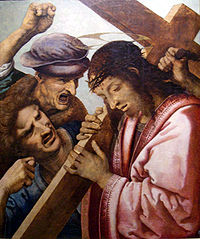
|
|
|
|
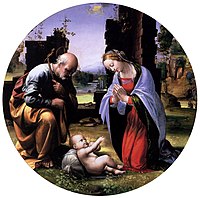
|
|
|
|
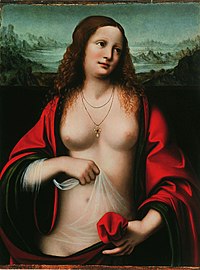
|
|
|
|

|
|
|
References
- ^ a b c d e f g h i j k della Chiesa, Angela Ottino (1967), The Complete Paintings of Leonardo da Vinci, Penguin, ISBN 0-1400-8649-8
- ^ Giorgio Vasari, Lives of the Artists, 1568; this edition Penguin Classics, trans. George Bull 1965, ISBN 0-14-044-164-6
- ^ M. Kemp, entry for The Lady with an Ermine in the exhibition Circa 1492: Art in the Age of Exploration (Washington-New Haven-London) pp 271f, states "the identification of the sitter in this painting as Cecilia Gallerani is reasonably secure;" Janice Shell and Grazioso Sironi, "Cecilia Gallerani: Leonardo's Lady with an Ermine" Artibus et Historiae 13 No. 25 (1992:47-66) discuss the career of this identification since it was first suggested in 1900.
- ^ Universal Leonardo: Leonardo da Vinci online › Trails › The Natural World
- ^ "Arrests after da Vinci work found". 4 October 2007. Retrieved 2008-02-22.
{{cite news}}: Text "BBC News" ignored (help) - ^ Shearman, John (1992), Only Connect...: Art and the Spectator in the Italian Renaissance, Oxford: Oxford University Press, p. 33
- ^ Arasse, Daniel (1997), Leonardo da Vinci, Konecky & Konecky, ISBN 1 56852 1987
- ^ a b c Stephane Fitch DaVinci's Fingerprints, 12.22.03 accessed 7 July 2009. Martin Kemp, the expert on Leonardo's fingerprints, had not examined the painting when the article was written.
- ^ A similar image, without the tormentors, is in the Hermitage Museum, St Petersburg. [1]
- ^ Arie, Sophie (16 February 2005). "Fingerprint puts Leonardo in the frame". The Guardian. Retrieved 2007-09-27.
- ^ "A lost Leonardo? Top art historian says maybe". Universal Leonardo. Retrieved 2007-09-27.
- ^ Bertelli, Carlo (November 19, 2005). "Due allievi non fanno un Leonardo" (in Italian). Il Corriere della Sera. Retrieved 2007-09-27.
- ^ Adams, James (October 13, 2009). "Montreal art expert identifies da Vinci drawing". The Globe and Mail. Retrieved 2009-10-14.
